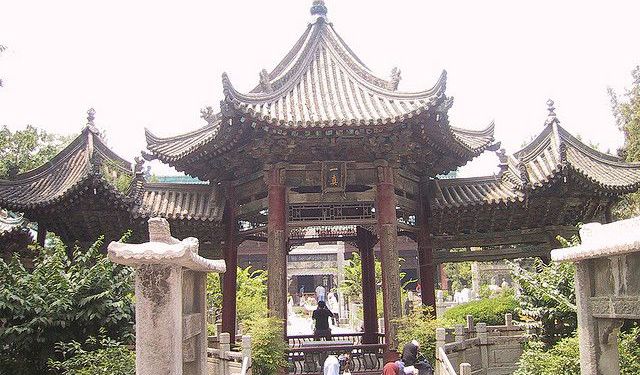
Green Dragon Temple, Xian
The Qinglong Si, also known as the Green Dragon Temple, dates back to the Tang Dynasty era, spanning from 618 to 907. This temple gained renown as a training hub for Buddhist monks and became a sought-after learning center for Japanese monks eager to study Buddhism. Its prominence in Japan is largely attributed to the Japanese monk Kukai, who studied there in 806 and played a pivotal role in popularizing Buddhism in Japan upon his return.
The original structure of the temple was destroyed, leading to the construction of a new one in 1963. Today, the temple, along with its gardens and halls, is a popular site, especially among Japanese tourists. They are particularly drawn to the cherry trees that blossom from March to May, varying slightly each year due to climatic changes.
In close proximity to the temple, there's a monument dedicated to Kukai, built recently, along with exhibition halls, remnants of Tang-era artifacts, and the picturesque cherry trees. The temple complex is divided into three main areas. The first includes a pond and a garden adorned with plum and cherry trees. The eastern section houses a memorial for Kukai, established in 1982 to mark the 1178th anniversary of his arrival in China.
The western part features a replica of the temple’s main hall, a collaborative project between Japan's Shingon Sect and the city of Xi'an, initiated in 1984. This hall was reconstructed to mirror the original Tang-era design, as determined by archaeological findings. The Shingon religion, founded by Kukai, continues to be a significant religious practice in Japan.
The original structure of the temple was destroyed, leading to the construction of a new one in 1963. Today, the temple, along with its gardens and halls, is a popular site, especially among Japanese tourists. They are particularly drawn to the cherry trees that blossom from March to May, varying slightly each year due to climatic changes.
In close proximity to the temple, there's a monument dedicated to Kukai, built recently, along with exhibition halls, remnants of Tang-era artifacts, and the picturesque cherry trees. The temple complex is divided into three main areas. The first includes a pond and a garden adorned with plum and cherry trees. The eastern section houses a memorial for Kukai, established in 1982 to mark the 1178th anniversary of his arrival in China.
The western part features a replica of the temple’s main hall, a collaborative project between Japan's Shingon Sect and the city of Xi'an, initiated in 1984. This hall was reconstructed to mirror the original Tang-era design, as determined by archaeological findings. The Shingon religion, founded by Kukai, continues to be a significant religious practice in Japan.
Want to visit this sight? Check out these Self-Guided Walking Tours in Xian. Alternatively, you can download the mobile app "GPSmyCity: Walks in 1K+ Cities" from Apple App Store or Google Play Store. The app turns your mobile device to a personal tour guide and it works offline, so no data plan is needed when traveling abroad.
Green Dragon Temple on Map
Sight Name: Green Dragon Temple
Sight Location: Xian, China (See walking tours in Xian)
Sight Type: Religious
Sight Location: Xian, China (See walking tours in Xian)
Sight Type: Religious
Walking Tours in Xian, China
Create Your Own Walk in Xian
Creating your own self-guided walk in Xian is easy and fun. Choose the city attractions that you want to see and a walk route map will be created just for you. You can even set your hotel as the start point of the walk.
Xian Introduction Walking Tour
Xian became a cultural and political center of China in the 11th century BC and was the capital city of eleven imperial Chinese dynasties.
For a western comparison, Xian closely resembles Rome. At the beginning of the first millennium, there were two major powers sitting at the ends of the civilized world, the Roman Empire in the west and the Han Dynasty in the east, each commanding roughly the... view more
Tour Duration: 2 Hour(s)
Travel Distance: 4.4 Km or 2.7 Miles
For a western comparison, Xian closely resembles Rome. At the beginning of the first millennium, there were two major powers sitting at the ends of the civilized world, the Roman Empire in the west and the Han Dynasty in the east, each commanding roughly the... view more
Tour Duration: 2 Hour(s)
Travel Distance: 4.4 Km or 2.7 Miles
Historical Religious Sites
A melting pot of different cultures and faiths, Xian, once the start of the historical Silk Road, for centuries had seen traders from far and wide come to do business. Many a foreigner eventually settled in Xian, bringing along their cuisine, customs, and religious practices. Hence the number of pagodas, Buddhist and Taoist temples, as well as mosques found in the city, some of which trace back... view more
Tour Duration: 1 Hour(s)
Travel Distance: 2.9 Km or 1.8 Miles
Tour Duration: 1 Hour(s)
Travel Distance: 2.9 Km or 1.8 Miles
Shopping Streets Tour
Back in the day, Xian was the starting point of the ancient Silk Road. Foreign traders used to come here to procure local merchandise such as tea, silk, and porcelain that were in high demand internationally throughout centuries.
In recent years, although the commercial center in China has shifted to the coastline area, Xian remains a major destination for quality shopping, especially when it... view more
Tour Duration: 1 Hour(s)
Travel Distance: 2.0 Km or 1.2 Miles
In recent years, although the commercial center in China has shifted to the coastline area, Xian remains a major destination for quality shopping, especially when it... view more
Tour Duration: 1 Hour(s)
Travel Distance: 2.0 Km or 1.2 Miles



